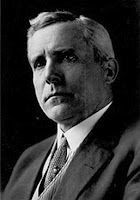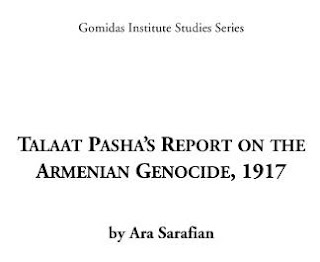Following the publication of the book named ‘Talat Pasha Evrak-ı Metrukesi (Documents Left Behind by Talat Pasha) by Murat Bardakçı in 2008, there were many interpretations of the book as well as many extreme meanings attributed to it both in Turkey and in the west in the name of historiography.
Many comments were flying around some of which were,
‘Denied Deir-El-Zor Massacres’ by Sarafian;
Claim of Hilmar Kaiser about his ‘Death Record’ being a slap in the faces of Turkish historians (Sabrina Tavernise NYT March 8, 2009 - Nearly a Million Genocide Victims, Covered in a Cloak of Amnesia);
Taner Akçam finding the number of the deported low;
Yusuf Halaçoğlu finding the number of the deported high;
Fuat Dündar announcing the document to be the most important of all;
Kemal Çiçek finding the document worthless.
While this theatrical phenomenon of subjective historiography was going on in March 2009, I managed to publish in chronological order the official documents and statistics gathered from US-Armenian and European sources about the relocations of Ottoman Armenians until end of 1920 (until when the Turkish-Armenian War continued).
Link : Armenian Refugees Movements & Genocide Claims
The ‘Death Record’ claimed to be a slap in the faces of Turkish historians by Hilmar Kaiser must have been a slap in his on face after the documents I published, not to mention the fact that nothing serious was heard about the documents of Talat Pasha from that side.
By SABRINA TAVERNISE Published: March 8, 2009 NYT
Further more Taner Akçam, making a sudden reduction of 50% in his claim for the death toll of so-called genocide victims, announced the number as 800,000 in the TV program of Balçiçek Pamir which was a more defendable figure for him although the claim about the number of the so-called genocide victims by the related institutions and committees was 1.5 million.
Not being contented with the documents I published, we also issued the official records of League of Nations about the aid activities for Armenian Refugees.
However, Mr. Ara Sarafian, chairman of Gomidas Institute most probably was not very pleased with the outcome since he attempted to relate miraculously the ‘Deported Armenian’ records in the documents of Talat Pasha with the telegraphs of 1917, with the dream of coming up with a miracle result for the relocation.
[ Generated Analysis by Sarafian about Talat Paşa Evrak-ı Metrukesi ]Let me remind all of you who express their opinions based on comments by Sarafian of some points one more time:
1) It is very clear that the document presenting the general condition of Armenians after the relocation and attributed to Talat Pasha is used to try to give an image as if it is representing truths recently surfaced (that were being hid on purpose before) although a copy of the very same document with the same hand-writing is with the Attache archives and the telegraphs of 1917 that are referenced by Sarafian are in the Ottoman archives. The aim becomes evident when we hear the claims that the document had been prepared specially for Talat Pasha in order for him to be able to control the number of survivors and to mask the process as a security measure. Unfortunately when you do a simple math on 1914 population census figures, figures on the telegraphs of 1917 and numbers in Attache archives, you get the same result with the document attributed to Talat Pasha, all of these documents being readily available in the archives for many years. Also in the history journal issued by NTV, there is a document published by Derya Tulga dated November 2nd, 1922 and having a stamp on it as ‘true copy’ presenting the number of Armenians relocated as 924,158. The document published by Bardakçı about Talat Pasha is neither a secret nor something specially prepared for him.
Published by Derya Tulga in The NTV History Journal
2) In addition the expressions of Sarafian of ‘masking this process as a security measure’ and ‘his report was not meant for public disclosure and may well have been destroyed were it not for Talat’s untimely death in 1921’ are not appropriate and hereby I remind Sarafian of the official document prepared by American Ambassador Jackson dated February 3rd, 1916 about the Armenian population in Iraq and Syria. Someone who was in the intention of exterminating Armenians secretly would certainly not get Armenians counted by the American Ambassador with the presence of Armenian reverends.
[ US Archives State Department Record Group 59, 867.48/271 by Ara Sarafian, United States Official Documents on the Armenian Genocide, Vol II, s. 112-113 ]
3) Another remarkable comment by Sarafian is ‘Consequently, the eastern provinces of Erzerum, Bitlis, Van, Diyarbekir, Trebizond, Elazig and Janik were not included in the survey because they had been ordered to clear out their Armenian populations in the initial stages of deportations’. Sarafian went too far by further deepening his claim with the remark of ‘Talat knew that many Armenians had managed to escape from the Ottoman Empire, such as those who resisted Ottoman forces in Van in April 1915, as well as those who managed to flee across the Russian border in 1915-16. The number of people who escaped was probably around 150,000 and their ultimate survival was by no means clear. Thousands subsequently perished from privation and disease’. Sarafian did not even have to make any effort to see that a document belonging Lord Major Found proved that the number of the fleeing ones was 250,000 alone in 1915 and that Armenians were not only fleeing from Van but other provinces too.In addition to this, the number of the fleeing ones in the following years to Caucasia, Southern Russia and Iran is no less than 500,000.
Armenian refugees: Lord Mayor's Fund
nationalarchives.gov.uk
4) As a result Sarafian claims that 900,000 Armenians had been systemically terminated by basing his claim also on telegraphs of 1917. In response to this Fuat Dündar claims that since the document attributed to Talat Pasha does not include the number of Armenians in general assembly areas like Deir-El-Zor or Mosul but only includes the ones counted in the cities, there is no way that the claim of Sarafian about the number of Armenians who died can be true. Either way, it is not possible to form a claim based on the document attributed to Talat Pasha or on the telegraphs of 1917. However if Sarafian is in the intention of attaching to his claim for life, then he has to come up with other official and historical documents. He can start by checking the official documents from American archives proving that the number of survivors in Ottoman borders in 1921 is 624,900. He can then also take a look at the documents presented to the League of Nations if he wishes. He can even present the documents.I included in my article headed ‘Armenian Refugees Movement and Genocide Claims’ to world’s public opinion before the article becomes a slap in the face to Sabrina Tavernise. None of these documents are from Turkish archives, they are all official documents and they all include historical information and dates.
U.S. National Archives and Records Administration - NARA, T 1192 R2. 860J.01
The document in Talat’s archive brings forth the following:* The document does not include either dates or a general outcome based on calculations and therefore does not have unique importance alone in its current form.
* It becomes an extra useful item for calculation following the presentation of Armenian Refugee numbers from the archives of League of Nations in years following WW1.
* It is useful in the sense that it pulls down the baseless claim of Armenian Patriarchate about the Armenian population in the Ottoman Empire before 1914 of 2 million back to its real levels of 1.5 million.
* What has been said and commented about the document produce more efficient results than what is included in the document itself.
 In 1920, the U.S. Senate was considering President Woodrow Wilson's pet project, a "mandate for Armenia," which, if approved, would have been the country's first Vietnam.
In 1920, the U.S. Senate was considering President Woodrow Wilson's pet project, a "mandate for Armenia," which, if approved, would have been the country's first Vietnam.  Volume I of The Cambridge History of Turkey examines the rise of Turkish power in Anatolia from the arrival of the first Turks at the end of the eleventh century to the fall of Constantinople to the Ottomans in1453. Taking the period as a whole, rather than dividing it along the more usual pre-Ottoman/Ottoman fault line, the volume covers the political, economic, social, intellectual and cultural history of the region as the Byzantine Empire crumbled and Anatolia passed into Turkish control to become the heartland of the Ottoman Empire. In this way, the contributors to the volume engage with and emphasise the continuities of the era rather than its dislocations, situating Anatolia within its geographic context at the crossroads of Central Asia, the Middle East and the Mediterranean.
Volume I of The Cambridge History of Turkey examines the rise of Turkish power in Anatolia from the arrival of the first Turks at the end of the eleventh century to the fall of Constantinople to the Ottomans in1453. Taking the period as a whole, rather than dividing it along the more usual pre-Ottoman/Ottoman fault line, the volume covers the political, economic, social, intellectual and cultural history of the region as the Byzantine Empire crumbled and Anatolia passed into Turkish control to become the heartland of the Ottoman Empire. In this way, the contributors to the volume engage with and emphasise the continuities of the era rather than its dislocations, situating Anatolia within its geographic context at the crossroads of Central Asia, the Middle East and the Mediterranean. Elmas and Dilek Kurban (TESEV), October 2010
Elmas and Dilek Kurban (TESEV), October 2010
















 ) if you see any copies of the following comments published other than http://armenians-1915.blogspot.com/
) if you see any copies of the following comments published other than http://armenians-1915.blogspot.com/